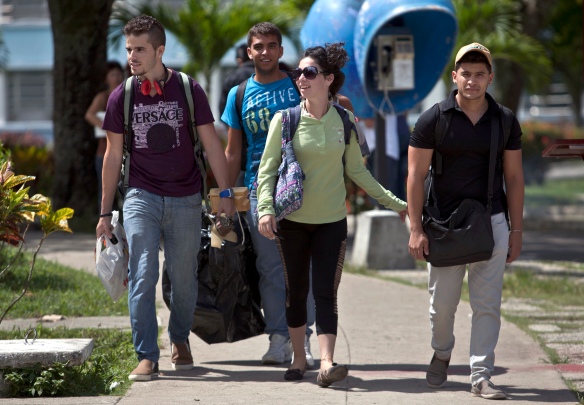How one Cuba scoop led to another
especiales

In a memo to staff, Senior Managing Editor Michael Oreskes hails the AP reporting team from around the world who worked together to break an important story about the U.S. government’s secret activities in Cuba:
It could be the makings of a James Bond movie: secure phones and encrypted emails used by AP reporters trying to penetrate a government program whose operatives were themselves using secret codes and trade craft. “I have a headache” really meant “They are watching me.” And “Your sister is ill” translated to “Time to get out.”
But it’s not fiction. It’s all part of this week’s Beat of the Week _ an accountability story furthering AP’s exclusive reporting on U.S. government efforts to stir political change in Cuba.
When does one scoop lead to another? When you’re the investigative team that this spring exposed a U.S. government program that created a secret “Cuban Twitter” text messaging service to encourage unrest on the communist island.

In this July 11, 2014, photo, Cuban students exit Marta Abreu Central University in Santa Clara, Cuba. Beginning as early as October 2009, a project overseen by the U.S. Agency for International Development sent Venezuelan, Costa Rican and Peruvian nationals to Cuba to cultivate a new generation of political activists. (AP Photo/Franklin Reyes)
Several weeks after that explosive piece hit the wire, reporter Desmond Butler‘s source gave him a new batch of documents. Tucked inside were details about security protocols with the secret codes and details of a story about an Obama administration program that secretly dispatched young Latin Americans to Cuba using the cover of health and civic programs to provoke political change.
The participants worked undercover, often posing as tourists, and traveled around the island scouting for people they could turn into political activists. But the clandestine operation _ which the AP found was continued even after the arrest of a U.S. contractor for smuggling technology into Cuba _ put those young operatives in danger.
Months in the making under the purview of international investigations editor Trish Wilson, the story reunited the original Cuban Twitter reporting team of Butler, the AP’s chief correspondent in Turkey; Washington investigative reporter Jack Gillum; Mexico-based Alberto Arce; and Andrea Rodriguez and Peter Orsi in Havana. Andean bureau chief Frank Bajak chased Peruvians involved in the project, and Hannah Dreier reported from Venezuela.
Technology played a key role in the reporting efforts: Gillum dumped the source documents into AP’s internal document repository so everyone could pore over them. He and Butler set up a [mechanism], so that reporters could see one another’s notes and contributions _ including the travelers’ contact data and interview transcriptions. Gillum also obtained key USAID emails warning contractors from travel to Cuba.
Arce helped translate the source documents, many of which were in Spanish, and interviewed four Costa Ricans who took part in the program, including Fernando Murillo, who ran an HIV prevention workshop in Cuba.
In Cuba, Rodriguez and Orsi doggedly hunted down the Cuban participants, and Rodriguez persuaded them to speak to AP on camera, no small feat given the backlash they could have faced.
Dreier, like everyone else who joined the project, had to learn to use [a secure phone]. She also set up an account to receive encrypted email because communications in Venezuela, like Cuba, are not considered secure. Dreier found four of the Venezuelan travelers, and got the money quote from a woman who acknowledged they were trying to “stir rebellion.”
Orsi reviewed the Spanish documents to ensure all translations were accurate, working meticulously to check every detail and finding last-minute changes made just hours before the story was published.
Video got involved early on. First came the interviews with the young Cubans, who said they did not know they were targets of the program.
Then London-based correspondent Raphael Satter tracked down the main organizer of the young Venezuelans recruited to go to Cuba, living now in a small house in Dublin, Ireland. Satter, along with Belfast-based cameraman John Morrisey, tried repeatedly to contact the woman, but she wouldn’t talk and even hid in her bedroom when they came knocking on her door. Their doggedness paid off after several hours when she did come out. She still refused to talk, but Morrisey got a compelling piece of video as the woman ran back into the house, slamming the door behind her.
As the story came together, Washington video supervisor David Bruns donned many hats _ voicing and editing the video piece, as well as creating graphics. A gallery of photos by Franklin Reyes, Esteban Felix and James L. Berenthal also illustrated the story.
The story played widely in newspapers worldwide and on the Internet, showing up on front pages in Mexico and Miami. Several team members appeared on NPR, Fox News and Telemundo, among other media outlets.
For their multinational effort that broke news and kept the AP out front on American secret activities in Cuba, Butler, Gillum, Arce, Rodriguez, Bajak, Dreier, Orsi and Bruns win this week’s $500 prize.













Add new comment